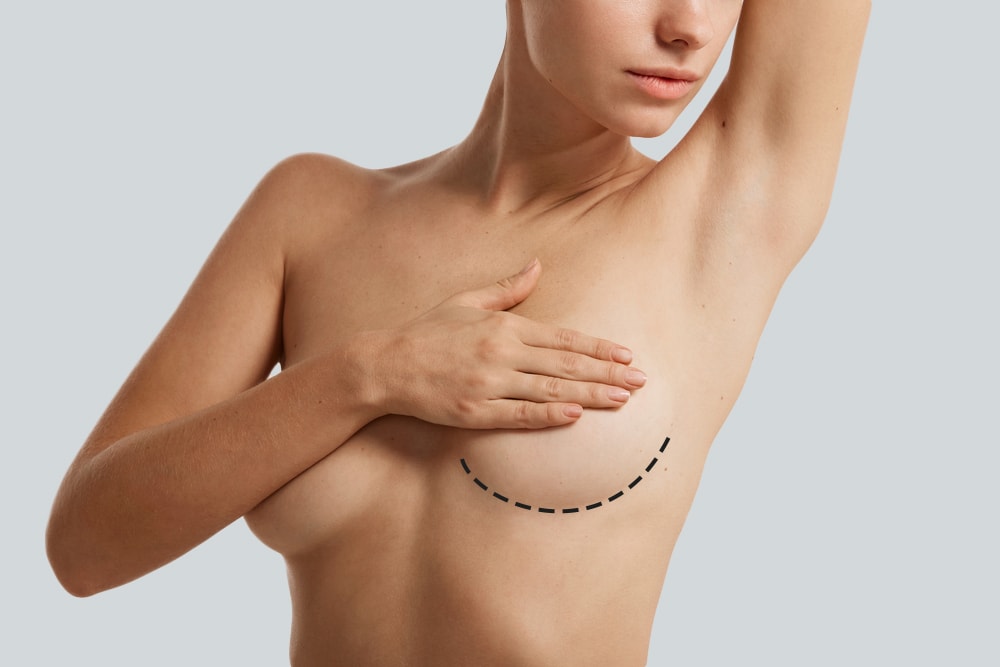If you are unhappy with the size and/or shape of your breasts, you are not alone. As one of the most popular procedures performed at Reno Tahoe Plastic Surgery, we can offer you many options when it comes to breast enhancement surgery. Through the placement of saline or silicone implants, breast augmentation can enhance the shape and increase the size of your breasts, as well as correct asymmetry. Our female plastic surgeons, Tiffany McCormack, MD and Nichole Joslyn, MD, believe in providing a natural result that will help you feel more confident about your body without the outcome appearing “fake” or artificial.
There are many reasons why women enlist a board-certified Reno plastic surgeon to undergo breast augmentation, including to reshape breasts that have lost their size/shape due to breastfeeding or weight loss; to make the breasts larger and more proportional to their overall body shape; or to balance breasts that are different sizes. That being said, your reasons are personal and unique. Your decision to undergo breast augmentation should be based on your own needs and expectations.
- Breast Augmentation Benefits
- Breast Augmentation Candidates
- Types of Breast Implants
- Breast Augmentation Incisions
- Breast Implant Placement
- Breast Augmentation Procedure
- Breast Augmentation Recovery
- Breast Augmentation Results
- Breast Augmentation Cost
- Breast Augmentation Scars
- Breast Implant And Breastfeeding
- Breast Augmentation Plus Lift
- 3D Breast Implant Imaging
- Non-Surgical Breast Augmentation
- Breast Implant Complications
- Breast Augmentation FAQs
What are the Benefits of Breast Augmentation?
Breast augmentation offers a number of benefits to women who wish to enhance the appearance of their breasts. Depending on your specific needs and goals, implants can help:
- Increase breast size and fullness
- Restore lost volume caused by pregnancy, weight fluctuations, or simply aging
- Enhance the curvature, contour, and symmetry of the breasts
- Make the breasts more proportionate to your frame
- Improve the look and fit of certain tops, swimsuits, and bras
- Boost your self-confidence in social and intimate settings

Types of Breast Implants
Breast implants come in many styles and sizes. Choosing the size that is right for you is based on specific measurements, as well as the look that you are hoping to achieve. Your plastic surgeon will spend time discussing your desired breast augmentation outcome and measuring you to help choose an implant that fits your body type while giving you the individual appearance you want to obtain. Please visit our breast implants page to learn about your implant options in greater detail.
Saline Implants
Saline breast implants are FDA-approved for patients who are 18 and older. They are filled with a saline (saltwater) solution and typically provide a soft, round breast shape. When compared to silicone, saline implants offer visible indications of a tear or leak. Implant rupture is rare, but the saline solution is typically safely absorbed by the body should it occur.
Form-Stable Implants
Form-stable, or “gummy bear,” implants typically provide a teardrop-shaped breast contour. They are made of a thicker silicone gel when compared to silicone implants and can be especially natural-looking for patients who lack fullness in the upper poles of the breasts. Form-stable implants may also minimize the risk of implant rippling and implant rupture.
Silicone Implants
Silicone implants are made of a silicone gel fill material, and FDA-approved for patients who are at least 22 years old. These implants are known to be firmer and more realistic to the touch than saline prostheses. Silicone implants are also favored for producing a very natural-looking breast contour. Unlike saline, silicone implants typically keep their shape in the rare event of rupture.
In addition to size and shape, breast implants are available in different profiles each of which offer a different projection. Breast implants come in a low profile, moderate profile or high profile. High profile implants provide the greatest forward projection and tend to be designed for a narrower chest. Dr. McCormack and Dr. Joslyn will show you the differences between implants and guide you toward the best option for your body type.
Where are Breast Augmentation Incisions Located?
Depending on your body type and the size of the breast augmentation desired, breast implants can be placed through an incision made around the areola, underneath the arms, or in the lower fold of the breasts. Dr. McCormack and Dr. Joslyn will discuss the pros and cons of the incision site specifically recommended for you. Keep in mind, the incision for silicone gel breast augmentation will be slightly larger than when compared to saline breast augmentation.

Breast Implant Placement
During breast augmentation, implants can be placed either above the pectoral muscle (subglandular) or below the pectoral muscle (submuscular/subpectoral). Generally speaking, subglandular placement can provide excellent results for individuals who have an ample amount of skin and breast tissue to cover the implant, as insufficient skin and tissue coverage may cause the implant itself to be noticeable and/or lead to visible rippling. For patients who do not have enough skin and tissue coverage, submuscular placement will often provide a better outcome. In addition to improved soft tissue coverage, this location provides good support for the weight of the implants and has proved to help decrease the chance of noticeable rippling.
Ultimately, there are advantages and disadvantages to both subglandular and subpectoral implant placement, all of which can be thoroughly reviewed during your consultation with your plastic surgeon to determine the most appropriate technique for you.
How is the Breast Augmentation Procedure Performed?
To begin the breast augmentation procedure, Dr. McCormack and Dr. Joslyn will carefully make incisions in the location that was agreed upon during the consultation. The chosen breast implants are then gently inserted through these incisions and placed either underneath or on top of the pectoralis muscle, depending on what was previously determined. When each implant is situated properly and an ideal breast shape is attained, Dr. McCormack or Dr. Joslyn will use tiny surgical sutures to meticulously close the incisions.
The total treatment time is usually about one to two hours, though this may vary based on whether the breast augmentation is combined with a breast lift and/or other procedures as part of a Mommy Makeover. Performed on an outpatient basis, patients are typically able to return home the same day with the assistance of a close friend, spouse, or relative.
What is Recovery From Breast Augmentation Like?
Breast augmentation surgery is commonly performed as an outpatient procedure, and most patients are able to return to work in one to two weeks. It is normal to feel somewhat tired and sore for several days following breast augmentation. You may also feel tightness in the chest area for some time. To minimize your risk of complications such as hematoma (bleeding around the implant), we recommend that you limit your activity for the first two weeks. Strenuous activity should be avoided for six to eight weeks following breast augmentation. You will be given antibiotics to minimize your infection risk, and we will instruct you to use specific breast massaging techniques following your surgery to help keep your breasts mobile, soft and natural-looking, and to help prevent capsular contracture (excess scarring around the implant from the inside).
It is normal for your breasts to appear high and swollen for several weeks following your surgery until they “drop” into a normal position. One breast may drop before the other and this is not a cause for concern. You may experience numbness in the nipple/areola that is often due to swelling, and usually resolves naturally. In a small number of patients, the numbness or lack of sensation will remain permanent.

How Long Do Breast Implants Last?
While breast implants are not designed to be lifetime devices, they can provide long-lasting results for decades. Breast implants usually do not have to be replaced unless you desire a different size/type of implant in the future, or unless a complication arises. These may include the development of scar tissue around an implant (capsular contracture) or implant rippling—the ability to see or feel an implant’s edges. In either case, a breast revision procedure can be pursued if necessary to address any issues with breast implants or to fulfill a change in your preferences. Dr. McCormack and Dr. Joslyn recommend regular breast screenings and wellness exams to help ensure your implants are still in good condition.
How Much Does Breast Augmentation Cost?
The average cost of breast augmentation typically includes associated surgical fees for the anesthesia, operating facility, and other related expenses. However, breast augmentation is priced according to the unique details of your treatment plan, including the type of implants chosen, the surgical technique utilized, and the overall complexity of your procedure. For this reason, an accurate cost estimate cannot be determined until you have a consultation with your plastic surgeon
In addition to the major methods of payment, Reno Tahoe Plastic Surgery accepts financing plans from qualified patients who prefer to pay for their procedure in a series of manageable installments. This is offered through highly reputable healthcare lending institutions like CareCredit®, ALPHAEON™ Credit, and Prosper® Healthcare Lending. Each financing company offers low- to no-interest payment plans that can be chosen based on a patient’s budgetary concerns. We would be happy to assist you with any other questions or concerns related to the cost of breast augmentation. Please call our office at (775) 284-2020 to speak to a friendly member of our team.

Will I Have Visible Breast Augmentation Scars?
Although scarring after any surgical procedure is inevitable, breast augmentation scars can be discreet depending on the incision technique utilized for your surgery. If your implants were inserted through an incision made around the areolas, scars are often camouflaged by the natural change in pigmentation between the skin and nipples. Similarly, incisions made along the breast crease can generally blend into the natural contour underneath the breasts. For incisions placed along a fold of the underarm, your scar should only be visible when the arms are raised. The breasts themselves should be left unblemished. Dr. McCormack and Dr. Joslyn are very diligent about placing incisions inconspicuously whenever possible, thereby minimizing the extent of post-surgical scarring.
Is Breastfeeding Still Possible After Breast Augmentation?
If you are able to breastfeed prior to breast augmentation, you should be capable of doing so after treatment—assuming the procedure is performed safely and correctly by a board-certified plastic surgeon. Unfortunately, some women are unable to produce enough milk for breastfeeding in the first place, so if they have not attempted to breastfeed before breast augmentation and find they cannot do so afterwards, they may wrongly attribute this inability to the presence of implants.

Breast Augmentation Plus Lift
Implants are placed to make the breasts larger—it is important to understand that implants alone may not adequately lift the breasts, or correct the effects of pregnancy, weight loss, or skin stretching. Our plastic surgeons may suggest additional procedures at the time of breast augmentation, such as a breast lift (mastopexy), to optimize your results. Referred to as a breast lift with implants or a breast augmentation with a lift, this combination procedure can increase the size of your breasts while also raising them to a more youthful location on the chest wall. To learn about this joint surgery, please visit our page dedicated to a breast lift with implants.
3D Computer Breast Implant Imaging
With VECTRA® 3D Imaging, Dr. McCormack and Dr. Joslyn will be able to accurately answer the number one patient question: “What will I look like after surgery?” Using the revolutionary VECTRA® computer imaging system, she can accurately give you an idea of how your breasts may look after breast augmentation. This can help you make decisions about the ideal implant size, shape, and profile to achieve your desired look. View the “new you” from any angle and easily compare pre-op and post-op photos for a better understanding!
Is Non-Surgical Breast Augmentation Possible?
Reproducing the results of breast augmentation without surgery is not possible. The only way to aesthetically reshape the breasts while enhancing size and reshaping the chest contours is through a breast procedure. While some online trends purport that certain workouts or exercises can improve the appearance of the breasts, these claims are not supported by any research or clinical results. If anything, chest-targeted workouts only strengthen the pectoral muscles and do nothing to increase fullness or add volume.
We encourage you to communicate your needs and preferences to your plastic surgeon so our team can formulate an optimal treatment plan to achieve your goals. With the many minimally invasive treatments available through M Spa, patients can often find a variety of non-surgical facial rejuvenation, skincare, and body contouring services to address their concerns.
What are the Most Common Breast Implant Complications?
Breast implants can offer state-of-the-art results, but they’re not impeccable devices. Changes in the look or feel of your breasts after surgery may indicate a complication, the most common of which includes:
- Implant rippling: When the edges of the implant are easily seen or felt through the skin, thereby making the results look less natural.
- Implant rupture: A tear in the implant, sometimes offering visible indications of rupture in the case of saline implants.
- Scar tissue formation: Hardened scar tissue around the breast capsule(s), potentially causing pain, tightness, or swelling.
Fortunately, many of these concerns can be corrected with a breast revision procedure. While there is always a risk of potential complications with breast surgery, you can maximize your safety and results by selecting a board-certified plastic surgeon to perform your surgery. Those accredited by the American Board of Plastic Surgery (ABPS) often have the highest levels of training in breast augmentation, as well as breast procedures in general.
Breast Augmentation FAQs
Am I too old for breast augmentation?
There is no definitive upper age restriction for breast augmentation. In fact, Dr. McCormack and Dr. Joslyn have treated patients who were in their 50s, 60s, and older. More important than age is one’s overall health and an understanding of what can and cannot be realistically achieved with implants. Though every case is different, many patients who are seeking breast augmentation later in life will also require a breast lift to attain their desired results. This is particularly true for those who have had children and/or have undergone a significant weight reduction at some point in time.
Is breast augmentation or a breast lift better for me?
Breast augmentation is designed to increase the volume and/or improve the contour of the breasts; it will not significantly elevate sagging tissues or address loose, excess skin. As a result, if you are happy with the position of your breasts and are solely interested in enhancing size and shape, breast augmentation will likely be the most appropriate option for you.
In contrast, breast lift surgery is performed to eliminate extra skin and raise drooping breasts to a more youthful position on the chest—it will not add volume. With this in mind, mastopexy may be the best option for you if you are happy with the current size of your breasts but wish to correct excess skin and tissue sagging.
Fortunately, if you want to address breast sag while also enlarging your breasts, a combination of breast augmentation and breast lift surgery can usually be performed to achieve your goals. All of these details can be discussed more thoroughly at the time of your consultation.
Can I see examples of the results achieved with breast augmentation?
Yes! Your plastic surgeon will be able to show you the contents of our patient gallery during your consultation so you can obtain a better understanding of what can potentially be achieved with breast enlargement. Our online portfolio, as well as 3D imaging technology prior to surgery, should also give you more insight into the possible outcome of the procedure. Through breast augmentation with or without a lift, you can achieve a more shapely and feminine figure. View our breast augmentation before-and-after photos to explore results of previous patients who have received treatment at our practice.
Will breast implants affect mammograms?
Breast implants may or may not affect breast screenings depending on where the implant is placed. In general, implants placed underneath the chest muscle have less visibility during mammograms when compared to over-the-muscle implant placement. If you’ve undergone breast augmentation, our team advises communicating with the hospital or breast screening facility to ensure they have experience performing mammograms on women with implants. In many cases, extra images are captured for patients who have implants — these additional pictures are referred to as ID views, or “implant displacement” views.
Is breast augmentation safe?
When you’re under the care of a talented board-certified plastic surgeon, breast augmentation is considered a safe procedure with a long record of clinical results to support its predictability and effectiveness. While every surgery has its risks, an aesthetic plastic surgeon accredited by the American Board of Plastic Surgery (ABPS) offers the highest level of training in breast enhancement possible compared to other cosmetic providers. Having undergone a greater degree of training in breast surgery, a board-certified plastic surgeon is usually able to maximize the safety of your procedure and react appropriately in the rare event of complication.
Will I need to replace my implants in the future?
Implants typically only require replacement if you want an upgraded size, shape, or type of implant in the future, or in the rare event of rupture. Although they’re not designed to last a lifetime, many patients never experience any issues with their breast implants. Most complications associated with implants, such as rippling and scar tissue formation, can be corrected during a breast revision procedure if necessary. However, patients can also undergo a breast implant removal procedure if they feel they no longer desire their implants.
How do I sleep after breast augmentation?
During the recovery period, your plastic surgeon will likely advise you to sleep on your back or side to reduce the possibility of implant displacement and minimize unnecessary pressure on the breasts. Propping up pillows can help you remain on your side throughout the night for patients accustomed to sleeping on their stomach. Your plastic surgeon will discuss all necessary aftercare with you following your procedure.
How do I know which implant size is right for me?
The best implant size for your needs, body frame, and expectations for the outcome will be thoroughly discussed before your procedure. What’s more, our team at Reno Tahoe Plastic Surgery uses VECTRA® 3D imaging to create a virtual “preview” of how each implant size may affect your breasts and overall silhouette. Ultimately, Dr. McCormack and Dr. Joslyn will give you the information to help ensure you have a good understanding of the most ideal shape and size of implant for your unique procedure.
If you would like more information about the breast enhancement procedures we offer, please contact Reno Tahoe Plastic Surgery today.